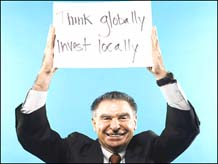More cream for the fat catsCorporate profits are at their highest level since 1929. Fortune's Justin Fox tells you what that means for the stock market in the coming year.(Fortune Magazine) -- Back in the dot-com years, profits were optional for many stocks. The market rose instead on bouts of exuberance and barrages of salesmanship. Those days ended during the meltdown of 2001-02, and since then investors have been demanding to see the money, in the form of profits. Lately they've seen a ton: S&P 500 earnings per share were up 18 percent in the four quarters ended Sept. 30 - and that's after a gain of 19 percent in 2005 and 20 percent in 2004. The market has responded in kind: The Dow Jones industrials hit new highs in 2006, and the S&P 500 has come tantalizingly close. So what can profits tell investors about where the market is heading?
Stocks have always derived their value from the anticipation of future profits. With the price/earnings ratio of the S&P - based on trailing earnings - stuck for most of the past year at its lowest levels since the mid-1990s, investors don't appear to be anticipating much. To keep the stock market rising in the face of such dubiousness, corporate earnings will have to keep rising too. Whether they can or cannot is a major economic question spurring debate on Wall Street. On one side of this debate are the skeptics, who believe that what goes up must come down. "I've kind of been born and bred on the understanding that capitalism is based on competition bringing down excessive profit margins and allowing depressed margins to rise back," says veteran value investor Jeremy Grantham in the Investor Roundtable. "And profit margins around the world, not just in the U.S., have gotten to be way over trend." The opposing camp argues that the factors keeping profits high aren't going away soon. "I think profits can stay at their lofty levels as a percentage of GDP," says Banc of America Investment Advisors chief market strategist Joseph Quinlan. The reason is all that "flat world" stuff: New technologies and the advent of a truly global labor market are allowing U.S.-based multinationals to do much more at lower cost. Regardless of whose view one shares, it's clear that something significant is going on: After-tax corporate profits equaled 10.1 percent of gross domestic product in the first nine months of 2006. In the 87 years the Commerce Department's Bureau of Economic Analysis has been measuring them, profits never even hit 9 percent of GDP before 2005. Somewhat ominously, they came closest in 1929 - at 8.9 percent of GDP. Before we start worrying about breadlines, it's worth pointing out that after looking at the impact of inflation on inventory values, the Bush administration's temporary tax incentives, and other distortions such as hurricanes, the BEA says true economic profits have actually been stuck at 7.5 percent of GDP since 2004 - far from a record. That's a mixed signal: On the one hand, it says that reported profits are probably exaggerated; on the other, that real profits aren't insanely high. Still, even 7.5 percent of GDP is the highest profit share since 1997 (and before that, 1966). The money had to come from somewhere, and BEA data show that over the past five years much of it has come from lower worker compensation and lower interest rates. These are both factors investors would do well to watch in the months ahead. Employee compensation dropped from 58.9 percent of GDP in 2000 to 56.4 percent in 2005. (It rose slightly, to 56.5 percent, in the first three quarters of 2006.) There is, however, no discernible longer-term trend: Workers' share of the economy has been bouncing around between 56 percent and 59 percent since the mid-1960s. (Wages and salaries have lost ground, but higher Social Security, pension, and health insurance contributions have made up the difference.) That's why Grantham and Quinlan can sound reasonable making such opposite arguments - and why professional investors have been paying such close attention to every shred of information on labor costs. As for that other enabler of recent profit gains, falling interest payments - down from an all-time high of 8.2 percent of GDP in 1984 to 3.9 percent in 2006 - they simply can't go all that much lower. Then there are corporate taxes, which dropped from 6 percent of GDP in the 1950s to a postwar low of 1.8 percent in 2001 but are now back up to 3.6 percent. The message for investors from all this is to be cautious. There's no reason to think the market is about to tank - on the whole it isn't obviously overvalued. But there's good reason to fear that big profit increases may soon be a thing of the past, and with them the big market gains of the past four years. Even Quinlan, who doesn't think corporations are going to give up the ground they've won from labor in recent years, is worried that slower economic growth will nonetheless mean slower profit growth. What it all adds up to seems to be a forecast for a relatively flat stock market. But for some irritating reason, the market doesn't usually do flat. Beware, then, of falling stocks. _____________________ |
| ||||||||||||||

